-
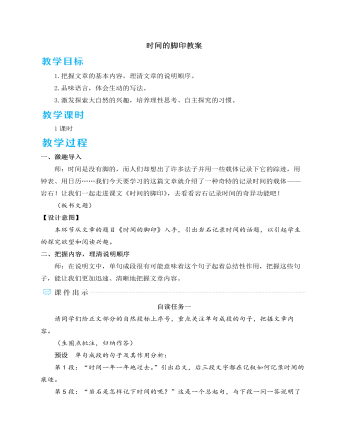
人教部编版语文八年级下册时间的脚印教案
四、总结归纳,延伸拓展师:作者“观古今于须臾,抚四海于一瞬”,把时间的概念,从人们日常的感觉延伸到自然界中,引出了关于时间的又一种境界。请同学们根据你所知道的课内外知识,完成下面的拓展任务:拓展任务一岩石记录时间的重要方式是它保存了许多的历史痕迹。请阅读课文第22—29段并分组讨论,说说岩石保存了哪些历史痕迹,它对人类有着怎样的意义,你从中得到了哪些启示。 (生分小组探讨,批注,然后交流回答)预设 示例:①记录了地壳的活动;②记录了气候的变化;③记录了古代生物的状况;④记录了地球历史的发展过程;⑤记录了自然界某些转瞬即逝的活动。意义与启示:对岩石的研究,不仅使我们增长了知识,对自然界与史前历史有了更多的认识,还使我们拥有了开发史前资源的可能性,能为人类谋取幸福。我们要秉承这种辩证主义思想观念,发扬科学探索的精神,在人类前行的历史上,贡献出一份力量。
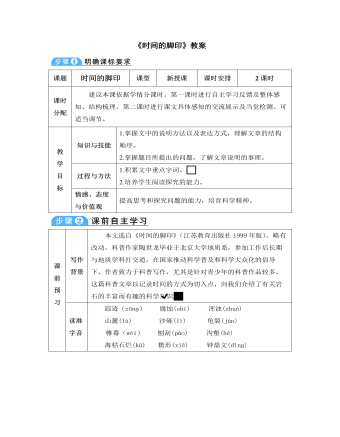
部编版语文八年级下册《时间的脚印》教案
【初读课文,整体感知】1. 以《时间的脚印》为题目有什么好处?文章的题目《时间的脚印》,是从高士其《时间伯伯》一诗中引申借用来的。其拟人化手法的运用,形象地说明了那些形形色色、大大小小的岩石中都潜藏着时间的踪影,以引起人们的探究欲望和阅读兴趣。【再读课文,梳理结构】1.第一部分(第1至第4自然段)说明岩石“是记录时间的方式中最重要的一种”。2.第二部分(第5至第29自然段)分层次地详细说明岩石是怎样记录时间的。这部分分三层。3.第三部分(第30自然段至全文完)总结全文,说明岩石记录时间的意义,号召人们进一步去大自然找寻时间的踪影,去一步步走向地下的宝库。【感悟精彩句子】1.“狂风来了,洪水来了,冰河爬来了”。

人教部编版语文八年级下册大自然的语言教案
【设计意图】学习事理说明文,要让学生在自主归纳的过程中,初步感知事理说明文说明“事理”这一基本特点,把握事理说明文和事物说明文的不同之处。引导学生通过学习课文,对科学方法产生自己的体会,并运用到自己的思考中。四、总结存储1.教师小结本文是一篇事理说明文,作者把一门科学——物候学介绍得浅显易懂,饶有趣味。全文采用逻辑顺序说明,思路清晰明了:描述物候现象——做出科学解释——追究因果关系——阐述研究意义。这种从现象到本质的认识方法和行文思路值得我们学习。本文语言严谨而生动,兼具说明的科学性和生动性,是一篇极有价值的科普文,是科学家竺可桢科学精神和科学思想的具体体现。文章启发我们:科学距离我们并不遥远,就在我们的身边,而想要探索它,就要有科学精神,扩大科学知识储备,掌握科学方法,勇于探索科学奥秘。
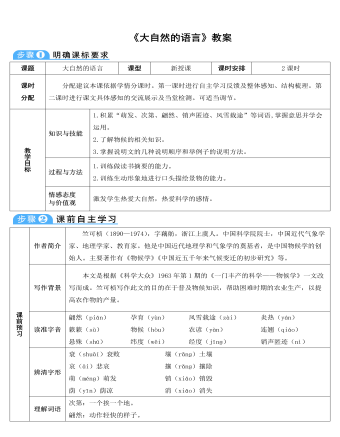
部编版语文八年级下册《大自然的语言》教案
结束这节课,我心里很轻松,因为在以往的教学中学生感觉到:说明文很单调、枯燥不生动。而本节课学生与我配合得非常好,原因是我利用多媒体展示的几幅画面,把学生的注意力都集中在所讲的内容中,并且调动了学生学习的积极性,认为物候现象就在我们的身边,激发学生探索科学奥秘的兴趣,更多地去了解大自然,认识大自然,热爱大自然。在初读课文的时候,我训练了学生的概括能力;在分清举例说明的方法时,让学生明白什么是举例子的说明方法;在细读课文的时候,让学生学习生动地有条理地说明事物的方法,还重点品味第一段的生动语言,在品味说明文语言的准确性时,有日常生活中的例子导入,深入浅出地讲解了说明语言准确性的两点情况。
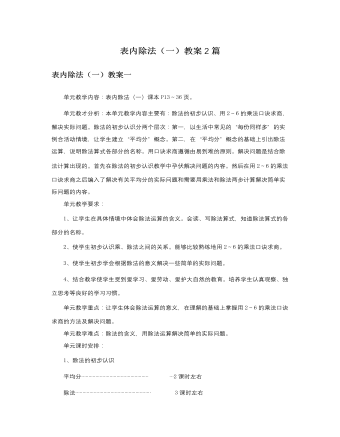
人教版新课标小学数学二年级下册表内除法(一)教案2篇
教后反思本节课给学生创设了良好的活动空间,把学生实际生活中听说过的见到的平均分现象展示给学生看,把生活和数学联系起来,在学生感受“同样多”的基础上概括出什么叫平均分。揭示平均分这一数学知识在生活中的应用,之后突出了学生三次实际操作。第一次,小组同学互相分水果,重视学生分的结果。体会感受“平均分”的含义。第二次,重视分法:15个橘子平均分成5份。体现了学生对物品的不同分法,建立了平均分的概念。第三次,分矿泉水,通过份数变化,观察分的就结果,深刻体会“平均分”,为认识除法积累丰富的知识。为学生营造探索的空间。第二课时:平均分的认识(二)教学内容巩固“平均分”。课本第15页的例题3。教学目标1.巩固“平均分”的概念,知道平均分就是每一份分得结果同样多。
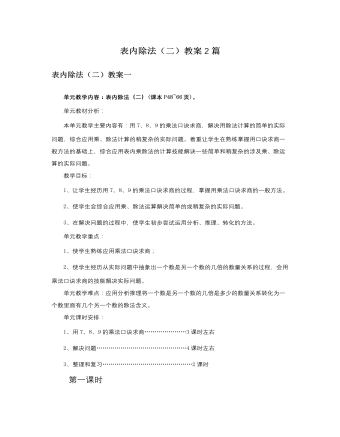
人教版新课标小学数学二年级下册表内除法(二)教案2篇
三维目标1.知识与技能(1)让学生经历用7、8、9的乘法口诀求商的过程,掌握用乘法口诀求商的一般方法。(2)使学生会综合应用乘、除法运算解决简单的或稍复杂的实际问题。2.过程与方法在解决问题的过程中,让学生初步尝试运用分析、推理和转化的学习方法。3.情感、态度与价值观让学生在学习中体验到成功的喜悦,增强学生学好数学的信心。重、难点与关键1.重点:使学生熟练应用乘法口诀求商,经历从实际问题中抽象出一个数是另一个数的几倍的数量关系的过程,会用乘法口诀求商的技能解决实际问题。2.难点:应用分析推理将一个数是另一个数的几倍是多少的数量关系转化为一个数里面有几个另一个数的除法含义。3.关键:以解决问题为载体,培养学生的数感。

人教版新目标初中英语七年级下册Where is the post office教案2篇
Period 2 (3a----Section B 2c)Preview(Pre-task): Key points: What laAdd another information about their pen pals----their language on the cardnguage does she/he speak?She/He speaks....Does she/he have any brothers and sisters? Does she/he speak English?Preview(Pre-task): Add another information about their pen pals----their language on the cardKey points: What language does she/he speak?She/He speaks....Does she/he have any brothers and sisters? Does she/he speak English?Step 1 Revision1.Revisionand dictation of the new words 2.Revise the drills they learned yesterday.(by pairwork and grammar exercise)Step 2 Leading-inT has a conversation with one student. The conversation is following:---Do you have a pen pal?---Yes, I do.---What's your pen pal's name? ---His/Her name is....---Where is your pen pal from? ---He/She is from...---Where does he/she live? ---He/She lives in....---What language does he/she speak?He/She speaks...Write the new words on the Bb. They are following: EnglishChineseJapaneseFrenchStep 3 LearnLearn the new words with the whole class.Finish 3a with the students3b Pairwork T still does an example with one student Then the Ss practise in pairs. The example is following:--Curry Muray is my pen pal. He is from the United States.---What language does he speak?

人教版新目标初中英语七年级下册Don’t eat in class教案2篇
Don’t fight. =You can’t fight. (板书,教读)教师把这些句子板书在黑板上,并请学生大声整齐地读祈使句和“can’t”句型,并让学生注意两种句型表达形式的不同和转换,“Don’t …=You can’t…”;并对学生说:These are our school rules. (板书,教读) You can’t break the school rules. Don’t break the school rules.(板书,教读)步骤3 :Practicea. T: Now, each of the students is breaking one of these rules.Please finish 1a.学生看图,完成1a的内容,检查答案并大声朗读校规。b. 听录音,完成1b,选出四位学生都违反了哪条校规;听之前,学生要读会英文名。c. 请两位学生朗读1c部分的句型;要求学生两人一组对话表演,SA扮演外校转来新生,SB告知本校校规。(学生可经过讨论,多说出他们想到的校规,不必只限于书上;教师应给予帮助)2) 第二课时(2a~4)步骤1 :warming up of revisionT: What are the rules at your school?学生使用“can”或祈使句表达各条校规;其中老师可引出“eat in the cafeteria outside”的表达。步骤2 :Practicea.T: Christina is an exchange student. She doesn’t know the rules. Let’s listen, what activities they’re talking about?学生听第一遍时,完成2a;第二遍时,完成2b;b. 请学生领读2c部分,看着2a完成的表格,理解2c活动的要求;分成小组针对2a进行问答;

人教版新目标初中英语七年级下册I ’d like some noodles教案
教学过程Step 1: warming-up Sing a song---------“food and drink” Step 2: Revision1 Dictation2 Revise: What kind of noodles would you like?I’d like …What size bowl of noodles would you like?I’d like…Step 3: Presentation1 show pictures of food, ask students say the words.2 Students read the newspaper ad in 3a. Fill in blanks with words in the box. Then read the ad together, the teacher explains some difficult language points.3 Check the answers Step 4 PracticeAsk students to finish 3b in the same way according to 3a. Students read the short passage and fill in the blanks .At last, check the answers.Step 5 productionAsk students to write their own ad for dumplings, noodles, drinks, and other foods they know. Then ask students to read their partner’s ad. Then order food and drink from their partner.Step 6 Home workGroup work – make an ad about “food and drink”

人教版新目标初中英语七年级下册Why do you like koalas教案2篇
单元整体说明(一)单元教材分析本单元的核心话题是描述动物和表达个人喜好,以及句式why do you like…? Because…。这也是本单元的教学重点。通过本单元的学习,学生应能较流利地运用所学词汇和句型描述动物,表达个人喜好。(二)单元知识结构1.词汇动物名称 tiger, elephant, koala, dolphin, etc.词汇描述性形容词: smart, cute, ugly, clever, shy, etc.国家名: Australia, South Africa2.句型Why do you like koala hears? Because they are cute.Where are pandas from? They're from China.What animals do you like? I like dolphins.(三)单元整体目标1.Master the vocabulary2.Master and use: Why do you like koalas? Because they am cute.Where are pandas from? They're from China.What animals do you like? I like dolphins.(四)单元教学重难点一览(五)单元学情分析学生此前已经学过由why, where, what 引导的特殊疑问句句型,具有了学习本单元知识的认知前提。形形色色的动物能激发学生的好奇心,产生了解它们的欲望,这有利于本单元知识的教学和学生学习兴趣的培养。

人教版新目标初中英语七年级下册How was your weekend教案2篇
Teaching Goal:1. General aims:Talk about recent past events2. Particular aims:A. Language Focus.Talk about recent past events and think of the past events.B. Language goalsHow was….?It was …What did …do over the weekend?C. Language structures:(1). How was your weekend? I was great. Pay attention to no form.(2). What did you do over the weekend? I played soccer. We went to the beach.D. Useful words and phrases:Words: was, did, went, beach, over, project, test, wasn’t, false, number, geography, spend, week, most, mixture, their, had, little, cook, read, saw, change, everyone, sit, sat, no, anythingPhrases: did one’s homework, played soccer, cleaned my room, went to the beach, played tennis, went to the movies, on Saturday morning, over the weekend, cook … for, what about, do some reading, have a party, talk show, go shoppingE. Grammar language:Present simple past tenseRegular and irregular verbsF. Learning strategies:Tour and holidaysG. Interdiscipinary:H. Emotion and manner:Teaching time: 5 periodsTeaching procedures:Period One教学步骤、时间 教师活动 学生活动 媒体应用Step 1Free talk 3’ Ask some questions like:Who’s on duty today?What’s the weather like? Answer and talk about something.让同学们回答下列问题1. Do you like weekend? (Let some students answer)It takes them three minutes to talk about the question.2. Why do you like weekend? (let the students answer) Most of the students like the weekend此时教师用汉语问:“在周末期间问你干了什么?这句话用英语这么回答?Let the students guess.At last the teacher give them right answer3. What did you do over the weekend?(板书、学习)

人教版新目标初中英语七年级下册What does he look like教案3篇
所需要用到的句子:Who is that?That is Jack. I like him.Why do you like him?I like him because he is interesting.Task 4: 设计理想中的人类Step one: 设计理想中的人类的外貌。把全班同学分成若干小组,学生可以边说边在纸上画出他们的模样。Step two: 设计理想中人类的性格。学生们可以把那些能描述性格的单词写在图画的旁边。Step three: 每组选出一名同学,其他同组同学提问,他作简单回答,并说明原因。所需用到的句子:What does he or she look like?He or she ...What is he or she like?He or she is ...Why?Because ...Task 5: 挑战性活动调查性格是天生的还是后天形成的,让每个同学回家去调查一下自己成长过程中性格是否有变化,具体是怎样的,为什么会这样? Teaching Aims:1. Enable students to have a general understanding of how to talk about people's physical appearance.2. Enable students to tackle some essential vocabularies and patterns about describing people. Provide them with necessary skills and methods.3. Create various chances for students to describe the persons they're familiar with, such as classmates, family members, teachers, idols, etc.

人教版新目标初中英语七年级下册I want to be an actor教案2篇
三、教学建议第一课时:1. Lead in (Vocabulary)A) Before class, teacher should collect some pictures of working places. For example: Bank, TV Station, Restaurant, Police Station, Hospital ...B) In class, show students the pictures (PowerPoint, OHP). Ask students to tell the name of the working places and the name of the jobs.Shop assistant, doctor, actor, reporter, police office, waiter, bank clerk, studentC) Do exercise 1a and 3a.2. Bingo GameAsk groups of students to make up pairs of cards with a job on one and the related workplace on the other. For example, waiter / restaurant, teacher / school, doctor / hospital. Encourage students to use both the job / workplace combinations in the book and the ones that students came up during class discussions. Be sure they have twice as many sets of cards as there are students in the group. They can make two sets of cards for a single job / workplace, if necessary. Then have each group mix up its set of cards and hand their cards out in random order. Each time a student gets a pair of cards that match, he or she can lay these cards down. The goal is to have no cards in your hand at the end.3. Task OneA) Ask students to work in pairs and ask the partner what does he / she want to be in the future.e. g. :What do you / does he / does she want to be?I want to be a.Why?Because it's (adj).B) Vocabulary: Section B, 1a4. Homework 1.2.

人教版新目标初中英语七年级下册It’s raining教案2篇
1 Each group choose one place to describe and what you are doing in it Choose one place, and describe what they are doing 2 Move around the room and give suggestions Talk about it and write it down 3 Ask one to show their works and act it Choose one of each group to make a report 4 Evaluate the best group and the best reporter Choose the best one Homework Ask your friends their ideal place and write about it教学反思:新课程标准中强调学生在课堂中的主体地位,在综合课中他们的主体地位就更加突出。在各个活动中给不同程度的学生不同层次的任务,让各层面的学生都有表现发挥的机会,从而产生对英语的兴趣。使用照片图片多媒体来辅助教学,效果更好。同时让了解其他国家风景,风俗的同学介绍ideal place,增加学生的背景知知识,实现跨学科交流的目的。教案点评:采用任务型教学模式,在各个活动中给不同程度的学生不同层次的任务,让各层面的学生都有表现发挥的机会,从而产生对英语的兴趣。使用照片图片多媒体来辅助教学,效果更好。让了解其他国家风景,风俗的同学介绍ideal place,增加学生的背景知识,实现跨学科交流的目的。

人教版新目标初中英语七年级下册Where is your pen pal from教案
2.1Match the country with the language.Step II Reading3a? let the students read the letter fast and answer the questions.? Let the students ask more questions about the letter as possible as the can.Step III Writing3b.Step IV. Pairwork2cStep V Listening2a, 2bStep V. HomeworkExercises book(1) P3Exercises book (2) P3Period FourStep I . Dictate the words and sentences in Unit1.Step II. Self-checkStep III. Check the answers for Exercises book in the unit.Step IV. Home workRevise and preparation for unit 2.教学反思:通过本单元的学习,学生基本可以谈论人们的国籍,居住城市及其所说的语言,通过书信方式去介绍自己并寻找笔友。但在涉及到国外的一些城市时,学生对这方面的知识相对欠缺,能介绍的城市并不多,也反应出学生课前预习不充分,这跟学生学习条件也有关,大多数学生无法通过网络获取所需信息。因此,在以后的教学中要多指导学生通过计算机网络获取信息,拓宽知识面。

人教版新目标初中英语七年级下册What do you think of game shows教案
五、教学Section B-2c1. Pair work: What do you think of the belt/sunglasses/…? What does your father/mother/… think of your scarf/belt…?2. Group work(1). Teacher shows some different kinds of school uniforms (制服)and asks : “ What do you think of your school uniforms? If you have a chance to choose your school uniforms, what kind would you like to choose?”(2). Discuss in groups.(3).Get some Ss to report in class.说明:这一步旨在让学生运用已有的语言知识谈论对事物的看法和意见,并简单阐明理由,培养学生的主动思维能力和运用英语的能力。六、教学拓展调查电视节目的收视率任务:调查你周围的人对现在各种电视节目的反响。活动过程:1.教师布置任务,让学生调查周围的人(包括他的亲戚朋友和邻居)喜欢收看哪方面的电视节目。2.学生进行调查活动,运用本单元所学的句型What do you think of….? (Why?)What's your favorite game shows?What do you think of talk show?I doesn’t mind it.I like it.I love it.I can’t stand it.3.记录下排在前10位的TV Program,填写调查表,比较其收视率。

人教版新目标初中英语七年级下册Where did you go on vacation教案
句型: Where did you go on vacation? I went to summer camp.Did she go to Central Park?Yes,she did.No, she didn’t语法:一般过去时特殊疑问句、一般疑问句及肯、否定回答。课时安排4课时第一课时:Section A:la,1b,lc,2a,2b,2c 第二课时:Section A:3a,3b,4第三课时:Section B:1,2a,2b,2c第四课时:Section B:3a,3b,3c,4 and Self Check第一课时教学目标掌握描写假期生活的形容词。假期里自己所做事情的简单表达。谈论假期做的事情及当时情况。谈论假期时旅游的天气,旅游者以及食物等。教学过程一、导入播放一首英文歌曲:Let’s travel 说明:通过让学生听节奏欢快迪斯尼英语歌曲Let’s travel.引入本节课谈论的话题vacation and travel. 让歌曲使学生的思维活跃,增强课堂气氛,激发学生提高学习英语的兴趣。T:How is the trip ?Ss : It’s pretty good/ happy/exciting /relaxing/busy/dangerous/ fantastic说明:这个问题是为了操练形容词。建议让多个Ss作答。鼓励他们用不同的形容词。上述个别形容词本应在第二课时中出现,但可以在warming-up中第一次非正式出现。这些形容词也可在老师的评价语中适时出现,以加深学生对词汇的印象。

人教部编版七年级下册太空一日教案
三、畅意表达,理解英雄1.畅意表达。师:通过学习课文,你们明白了杨利伟为什么被称为“航天英雄”吗?请同学们大胆表达自己的想法。(生自由交流回答)预设 杨利伟是中国人民解放军航天员大队的首飞航天员,圆满完成了中国的第一次载人航天飞行任务。在充满不可预料的各种危险和意外的情况下,杨利伟为了国家、民族的利益奋不顾身,他具有不怕牺牲、敢于牺牲的大无畏精神和拼搏勇气,所以被称为“航天英雄”。2.理解英雄。师:是否只有为国捐躯者才能成为英雄呢?请同学们四人一小组讨论一下,然后说说你们组的意见。(生小组内交流讨论后,推荐代表在全班交流,师指导明确)预设 不是的。凡是为了国家、民族的利益而不顾个人安危,并为此奉献出自己的智慧和力量的人,都应该给予英雄的荣誉。杨利伟在中国的第一次载人航天飞行中,遇到许多突发事件,危难考验不时出现,如果没有大无畏的精神,没有为国家、民族做贡献的意识,是不可能临危不惧、坚持到底的。
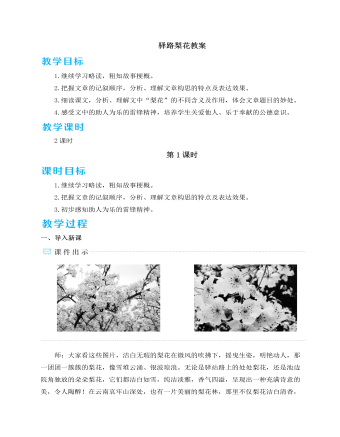
人教部编版七年级下册驿路梨花教案
预设 可能仍然有人在照料。虽然时代在变,然而雷锋精神并未消失。新时代涌现出许多热心善良、乐于助人、见义勇为、默默奉献的人,他们继续发扬着为人民服务的雷锋精神,他们的行为也表明了雷锋精神在代代相传,并发扬光大!社会因为他们的爱心、善举而变得温暖、和谐!2.作为新时代的中学生,我们该如何发扬雷锋精神?预设 时代需要雷锋精神,或许我们做不到像雷锋那样高尚,但我们可以做一些力所能及的事情,如公交车上给老人和孕妇让座,公共场合保持安静不大声喧哗,外出游玩遵守规则,遇到别人有困难,及时予以帮助等。从身边的小事端正自己的行为,自觉维护社会的公德,乐于助人、甘于奉献,才能共建和谐社会。【设计意图】此环节旨在通过阅读材料让学生明白雷锋精神一直在传承和发扬,并引导学生联系实际,在生活中践行雷锋精神,提高自我的公德意识。

人教部编版七年级下册语文邓稼先教案
语文新课标要求我们“在通读课文的基础上,理清思路,理解主要内容”。本文运用小标题来连缀全文,在教学过程中,有意识地引导学生结合小标题来理清文章结构,明确层次关系,进而轻松把握内容。本教学设计的各个环节始终抓住“理解人物精神品质”这一主线,环环相扣。从导入开始,就有意识地引导学生对人物形象有一个初步的把握;然后通过梳理事件、语言对人物的品格有一个较完整的认识;接下来通过研读课文关键语段,了解文中引文的作用,对人物精神品质的感悟更进一步深化;最后通过揣摩含义深刻的语句,来深刻感悟人物的崇高品格。此教学设计各环节由浅入深,逐层推进,符合初中生的一般认知规律,可操作性较强。背景链接本文选自1993年8月21日《人民日报》,有改动。邓稼先和杨振宁是有着50年友谊的同学。邓稼先为中国核武器事业的发展做出了重大贡献。




